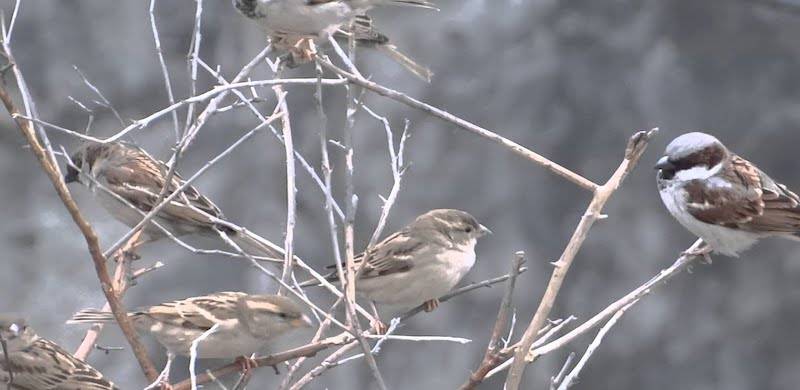
Lower Dir is one of the worst districts affected by climate change in Khyber Pakhtunkhwa. In the past few years, sparrows have become a rare species – which is a manifestation of human-induced climate change.
Kifayat Ullah, a resident of Haji Abad, a village in Lower Dir, recalls the abundance of sparrows in his area when he was a child. He would hunt them, but “we don’t see them any more,” he tells TFT.
According to the WWF report, sparrows in Pakistan are not on the Red List because nobody has counted them. Sparrows are on the UK’s IUCN Red List of Threatened Species, according to a report published in The Guardian. There are 247million fewer house sparrows in Europe now than there were in 1980.
“The construction activities in the region has caused unprecedented spike in temperature, which is directly affecting their reproduction cycle,” says Ijaz, Lower Dir Wildlife Department SDFO. He says that the department is now protecting wildlife under the KP Wildlife Act 2015, and is penalizing various offences pertaining to wildlife. He adds that various wildlife species are declared protected, and cannot be hunted unless the department issues a special permit.
“Sparrows help spread seeds away from the parent trees,” says Dr Anwar Hussain, Zoology professor at Abdul Wali Khan University Mardan. He adds that sparrows keep a check on the population of insects, as they eat insects such as grasshopper and snails. “They do not let the insect population grow beyond a certain limit. They play a role in the food chain as well, as predators, such as sparrow hawk and eagles and snakes feed on them.”
He adds that newborn sparrows eat insects for 15 days only, which is “a natural way to control the birth of insects and to protect crops from them”.
Hussain holds that urbanization has cause the disappearance of sparrows – “We are disturbing the nesting areas of these birds by cutting trees. Spraying pesticides damages the food chain, which ultimately disturbs their reproduction cycle,” he says, adding that rise in temperature has also impacted the population of sparrows in Lower Dir.
Environment journalist Asif Mohmand tells TFT that sparrows are finding it difficult to adapt to modern building structures. “Concrete emits heat at night, which affects their habitats.”
Excessive urbanization has increased the population of kites and crows that prey on sparrows. Mohmand says the climate crisis is a political issue, and only a policy change will bring change. He added that disappearing birds is an indicator that human's policies lack equilibrium. He added that human behaviour towards the environment should be friendly. Humans have to know about the Sustainable Development Goals which state that humans will have to know about species living with them.
“They do not let the insect population grow beyond a certain limit. They play a role in the food chain as well, as predators, such as sparrow hawk and eagles and snakes feed on them,” says Dr Anwar Hussain.
According to a news report, China launched a campaign to kill sparrows, known as “Smash Sparrow”. The campaign launched in 1958 by Mao Zedong, it was the worst ecological disaster known to mankind. Mao felt that sparrows ate too much grain and China could do without such pests. Thus, he decreed that all sparrows be killed. However, China discovered within a year that sparrows eat not just grains but also pests, such as locusts. An exponential growth in insect infestations, especially locust attacks, wreaked havoc on Chinese agriculture, and there were no more sparrows to eat them.
In 2012, the then Chief Minister of Delhi Sheila Dikshit declared house sparrows as the state bird of Delhi. Two years prior to that, the Indian Postal Department released a stamp featuring a house sparrow and a rock pigeon.
Raising awareness is critical -- to avoid stories such as, “Once upon a time there was a little bird called a sparrow...” For this purpose every year on March 20, World Sparrow Day honours the little, chirpy house sparrow and other birds.
In India, the government and civil society are serious about protecting sparrows. The Indian government has unveiled a ten-year strategy to protect birds and their habitats. There are at least 1,317 bird species, with roughly 100 of them classified as endangered in India.
The recent report of Intergovernmental Panel on Climate Change AR6 report states, “Human-induced climate change is causing dangerous and widespread disruption in nature and affecting the lives of billions of people around the world, despite efforts to reduce the risks.”
People and ecosystems least able to cope are being hardest hit, said scientists in the latest Intergovernmental Panel on Climate Change (IPCC) report. “Increased heatwaves, droughts and floods are already exceeding plants’ and animals’ tolerance thresholds, driving mass mortalities in species such as trees and corals. These weather extremes are occurring simultaneously, causing cascading impacts that are increasingly difficult to manage. They have exposed millions of people to acute food and water insecurity, especially in Africa, Asia, Central and South America, on Small Islands and in the Arctic.”

